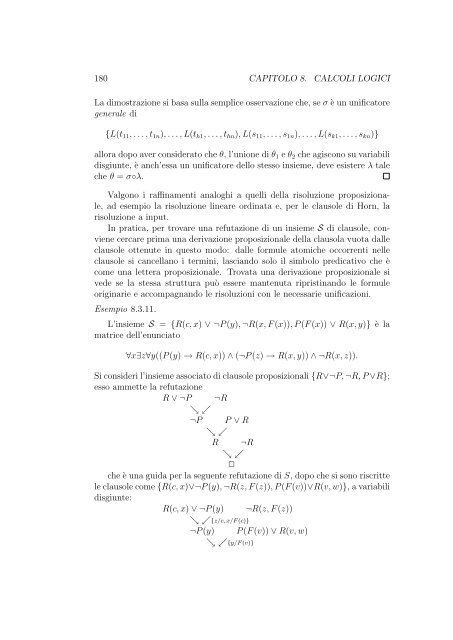Logica Matematica Corso di Laurea in Informatica ... - Mbox.dmi.unict.it
Logica Matematica Corso di Laurea in Informatica ... - Mbox.dmi.unict.it
Logica Matematica Corso di Laurea in Informatica ... - Mbox.dmi.unict.it
Create successful ePaper yourself
Turn your PDF publications into a flip-book with our unique Google optimized e-Paper software.
180 CAPITOLO 8. CALCOLI LOGICI<br />
La <strong>di</strong>mostrazione si basa sulla semplice osservazione che, se σ è un unificatore<br />
generale <strong>di</strong><br />
{L(t11, . . . , t1n), . . . , L(th1, . . . , thn), L(s11, . . . , s1n), . . . , L(sk1, . . . , skn)}<br />
allora dopo aver considerato che θ, l’unione <strong>di</strong> θ1 e θ2 che agiscono su variabili<br />
<strong>di</strong>sgiunte, è anch’essa un unificatore dello stesso <strong>in</strong>sieme, deve esistere λ tale<br />
che θ = σ◦λ.<br />
Valgono i raff<strong>in</strong>amenti analoghi a quelli della risoluzione proposizionale,<br />
ad esempio la risoluzione l<strong>in</strong>eare or<strong>di</strong>nata e, per le clausole <strong>di</strong> Horn, la<br />
risoluzione a <strong>in</strong>put.<br />
In pratica, per trovare una refutazione <strong>di</strong> un <strong>in</strong>sieme S <strong>di</strong> clausole, conviene<br />
cercare prima una derivazione proposizionale della clausola vuota dalle<br />
clausole ottenute <strong>in</strong> questo modo: dalle formule atomiche occorrenti nelle<br />
clausole si cancellano i term<strong>in</strong>i, lasciando solo il simbolo pre<strong>di</strong>cativo che è<br />
come una lettera proposizionale. Trovata una derivazione proposizionale si<br />
vede se la stessa struttura può essere mantenuta riprist<strong>in</strong>ando le formule<br />
orig<strong>in</strong>arie e accompagnando le risoluzioni con le necessarie unificazioni.<br />
Esempio 8.3.11.<br />
L’<strong>in</strong>sieme S = {R(c, x) ∨ ¬P (y), ¬R(x, F (x)), P (F (x)) ∨ R(x, y)} è la<br />
matrice dell’enunciato<br />
∀x∃z∀y((P (y) → R(c, x)) ∧ (¬P (z) → R(x, y)) ∧ ¬R(x, z)).<br />
Si consideri l’<strong>in</strong>sieme associato <strong>di</strong> clausole proposizionali {R∨¬P, ¬R, P ∨R};<br />
esso ammette la refutazione<br />
R ∨ ¬P ¬R<br />
↘ ↙<br />
¬P P ∨ R<br />
↘ ↙<br />
R ¬R<br />
↘ ↙<br />
✷<br />
che è una guida per la seguente refutazione <strong>di</strong> S, dopo che si sono riscr<strong>it</strong>te<br />
le clausole come {R(c, x)∨¬P (y), ¬R(z, F (z)), P (F (v))∨R(v, w)}, a variabili<br />
<strong>di</strong>sgiunte:<br />
R(c, x) ∨ ¬P (y) ¬R(z, F (z))<br />
↘ ↙{z/c, x/F (c)}<br />
¬P (y) P (F (v)) ∨ R(v, w)<br />
↘ ↙{y/F (v)}




![Introduzione ai sistemi Wiki [PDF] - Mbox.dmi.unict.it](https://img.yumpu.com/16413205/1/184x260/introduzione-ai-sistemi-wiki-pdf-mboxdmiunictit.jpg?quality=85)











